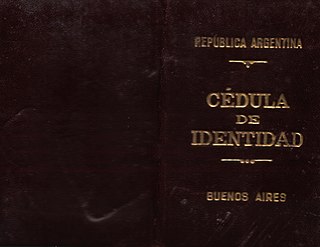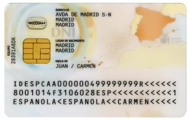
An identity document is a document proving a person's identity.
A national identification number, national identity number, or national insurance number or JMBG/EMBG is used by the governments of many countries as a means of tracking their citizens, permanent residents, and temporary residents for the purposes of work, taxation, government benefits, health care, and other governmentally-related functions.

Carteira de identidade Nacional is the official national identity document in Brazil. It is often informally called carteira de identidade, "RG" or simply identidade. The card contains the name of the bearer, filiation, place of birth, date of birth, signature and thumbprint of the bearer. Other national documents can legally be used as an identity card, such as a federative unit-issued driver's license, passport or, for minors, a birth certificate. Each card has a unique RG number. As of 11 January 2023, the CPF number will be used as the RG number on new identity cards.

An Argentine passportpronounced[pˌasapˈoɾteˌaɾxentˈino] ) are issued to citizens of Argentina by the National Registry for People (ReNaPer). They were issued exclusively by the Argentine Federal Police up to 2011. Their primary use is to facilitate international travel.

The Mexican passport is the passport issued to Mexican citizens for the purpose of travelling abroad. The Mexican passport is also an official ID and proof of Mexican citizenship. According to the January 2024 Henley Passport Index, holders of a Mexican passport can visit 159 countries without a visa, ranking Mexico 23rd in terms of global travel freedom.

The Estonian identity card is a mandatory identity document for citizens of Estonia. In addition to regular identification of a person, an ID-card can also be used for establishing one's identity in electronic environment and for giving one's digital signature. Within Europe as well as French overseas territories, Georgia and Tunisia the Estonian ID-card can be used by the citizens of Estonia as a travel document.
The NIE is a tax identification number in Spain, known in Spanish as the NIE, or more formally the Número de identidad de extranjero. The Spanish government have linked the NIE number to residence, where the NIE appears on the tarjeta de residencia, and to social security in Spain.

A cédula de identidad (Spanish), also known as cédula de ciudadanía or Documento de identidad (DNI), is a national identity document in many countries in Central and South America. In certain countries, such as Costa Rica, a cédula de identidad is the only valid identity document for many purposes; for example, a driving license or passport is not valid to open a bank account. The term "cédula" may also colloquially refer to the number on the identity document.

The Polish Identity Card is a national identity document issued to Polish citizens. As Poland is a European Union member state it is also serves a European Identity card. Every Polish citizen 18 years of age or older residing permanently in Poland is required to have an identity card issued by the local office of civic affairs. Children as well as Polish citizens living permanently abroad are entitled, but not required, to have one. Identity cards are valid for a period of 10 years.

The German Identity Card is issued to German nationals by local registration offices in Germany and diplomatic missions abroad, while it is produced at the Bundesdruckerei in Berlin.

The ArgentineIdentity card, Spanish: Documento Nacional de Identidadpronounced[dˌokumˈɛntonˌaθjonˈaldˈeˌiðentiðˈad] ) or DNI, is the main identity document for Argentine citizens, as well as temporary or permanent resident aliens. It is issued at a person's birth, and must be updated at 8 and 14 years of age, and thereafter every 15 years. It takes the form of a card, and is required for voting, payments, military service inscriptions and formalities. They are issued by the National Registry of Persons (RENAPER), at a special plant in Parque Patricios, Buenos Aires City.

The Portuguese identity card, is an identity document issued by the Government of Portugal to its citizens. The card replaces several previous documents, including the Bilhete de Identidade, Social Security card, National Health Service card, Taxpayer card and voter registration card, in one secure card. The Citizen Card was first issued in the Azores in mid-2006. However, as of 2017 BIs continued to be issued in some cases.

A card security code is a series of numbers that, in addition to the bank card number, is printed on a credit or debit card. The CSC is used as a security feature for card not present transactions, where a personal identification number (PIN) cannot be manually entered by the cardholder. It was instituted to reduce the incidence of credit card fraud. Unlike the card number, the CSC is deliberately not embossed, so that it is not read when using a mechanical credit card imprinter which will only pick up embossed numbers.
The Lebanese identity card is a compulsory Identity document issued to citizens of the Republic of Lebanon by the police on behalf of the Lebanese Ministry of Interior or in Lebanese embassies and consulates abroad free of charge. It is proof of identity, citizenship and residence of the Lebanese citizens.

The Dominican national identity card is a national identity card issued to citizens of the Dominican Republic. The polycarbonate card containing the holder's full name, place of birth, date of birth, nationality, sex, civil status, occupation, polling station, and residential address, as well as a photograph that adheres to ISO/IEC 19794-5. The card can also optionally include the holder's blood type. Formerly, it included the holder's race.

The Documento Nacional de Identidad (DNI) (Spanish for 'National Identity Document') is the only personal identity card recognized by the Peruvian Government for all civil, commercial, administrative, judicial acts and, in general, for all those cases in which, by legal mandate, it must be presented. It is a public document, personal, and non-transferable and also constitutes the only title of right to the suffrage of the person in whose favor it has been granted. Its issuance is in charge of the National Registry of Identification and Civil Status (RENIEC).
The Colombian Identity Card is the identity document issued to Colombian citizens by local registry offices in Colombia and diplomatic missions abroad to every Colombian person over 18 years of age. Minors are issued an identity card or "Tarjeta de Identidad”. It is the only valid identification document for all civil, political, administrative, and judicial acts, as mandated by Colombian Law 39 of 1961. The cards are produced and issued by the National Civil Registry.

The Identification Document, also known as Cédula de identidad, is the compulsory Uruguayan identity document, issued by the Ministry of the Interior through the National Directorate of Civil Identification (DNIC).

National identity cards are issued to their citizens by the governments of most Organization of American States (OAS) member states. The exceptions are Canada and the United States, although the latter issues a passport card which is a valid document in some countries.

The Argentina foreigner's identity card was a document issued to non-Argentine citizens living in Argentina.
















